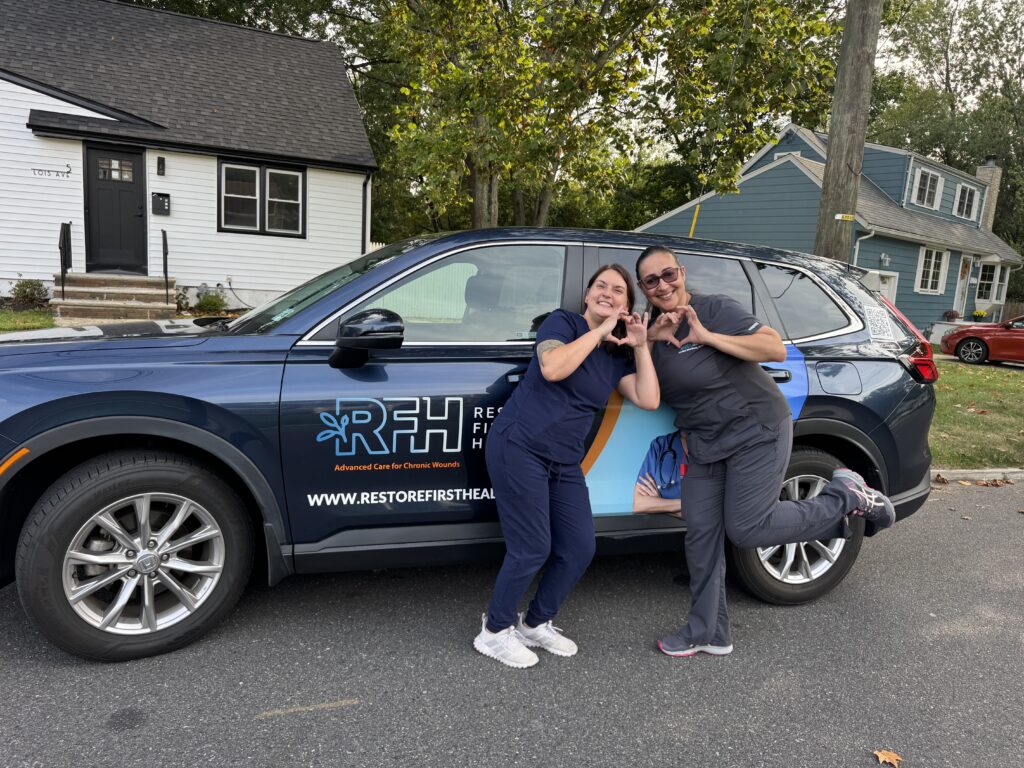When it comes to treating chronic wounds and chronic conditions, the time in between visits can affect the patient’s healing process.
At Restore First Health, we believe in ongoing communication, collaboration, and empowering those closest to the patient. That’s why one of the core pillars of our care model is care coordination; one of the most important parts of the healing journey.
Focus on the In-Between
Our mobile advanced health care is just one piece of healing a patient, without communication and care coordination, a patient’s healing can stall or even regress.
What makes a difference is what happens between visits; when a wound gets bumped, a dressing starts to slip, or chronic condition like COPD has a flare-up. That’s when families, nurses, and staff need a clear plan and someone to call.
Read: The First Symptoms of COPD and How Mobile Acute Care Brings Relief Home
Communicating a Clear Plan
Healing doesn’t follow a set schedule. It can stall, reverse, or take unexpected turns. Maybe a patient starts losing their appetite, and protein intake drops. Maybe moisture builds up under the wound dressing.
Our job is to make sure no one is left wondering what to do next.
- That means the home health nurse knows when to escalate.
- The facility CNA knows how to reposition correctly.
- The family caregiver knows what signs to look for.
And most importantly, they all know Restore First Health is here if something changes.
Like what you’re reading? Sign up for our newsletter.
What In-Between Visit Support Actually Looks Like
Real-Time Communication
We’re not just available at the visit, we stay in touch. That could mean answering a late-day question, reviewing a patient’s chart, or helping troubleshoot a chronic illness.
Clear, Practical Instructions
We break things down, so they make sense to everyone, not just clinicians. That means no medical jargon, no overcomplicated protocols. Just clear, step-by-step guidance that helps caregivers act with confidence.
Whole-Team Coordination
We don’t work in silos. We talk with everyone involved: home health, physicians, case managers, families. If they play a role in the patient’s care, they’re part of the conversation. That’s not just good practice, it’s essential to healing.
Why It Matters: Communication Saves Lives
Research backs it up. Communication breakdowns during transitions of care are one of the leading causes of preventable harm in healthcare, according to the Agency for Healthcare Research and Quality (AHRQ).
When details fall through the cracks, during a discharge, between provider handoffs, or when a question goes unanswered, patients suffer. And for those with chronic wounds or conditions, those details are often the difference between progress and a hospital readmission.
That’s why we put so much energy into bridging those gaps.
Watch: Better Patient Care Starts with Our 3 C’s.
It’s Not Just About Showing Up, It’s About Following Through
At Restore First Health, Care Coordination isn’t a box we check. It’s how we ensure:
- No one feels left in the dark
- Caregivers feel confident, not overwhelmed
- Everyone is aligned on what healing looks like
- Rehospitalizations are reduced because preventable issues are caught early
We’re here for the whole process, before, during, and after every visit.
What Happens Without Care Coordination
When there’s no coordination in the in-between:
- Chronic wounds or conditions stall or worsen
- Nurses burn out
- Families panic and turn to 911
- Everyone’s frustrated, and no one’s on the same page
Healing becomes tougher, for everyone.
Healing Takes a Team
Restore First Health keeps the patient’s whole care team connected.
If you’re a home health agency, a skilled nursing facility, or a family caregiver who’s tired of going it alone, know this: You don’t have to.
We’ll help guide the care, and make sure your team has what they need to keep it going in between.
Contact us today:
We’ll coordinate the care, so you don’t have to.
- Refer a patient. https://restorefirsthealth.com/refer-a-patient/
- Schedule a consult. https://restorefirsthealth.com/request-a-consultation/
Follow us to keep up to the date on the latest health news:
Patterson, E. S., & Wears, R. L. (2013). Patient Handoffs. In R. G. Hughes (Ed.), Patient Safety and Quality: An Evidence-Based Handbook for Nurses (Chapter 34). Agency for Healthcare Research and Quality (US). https://www.ncbi.nlm.nih.gov/books/NBK207234/
